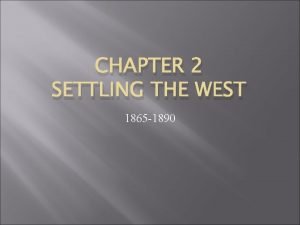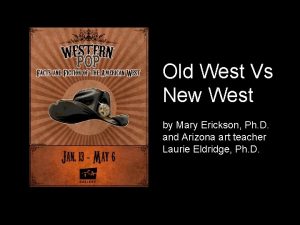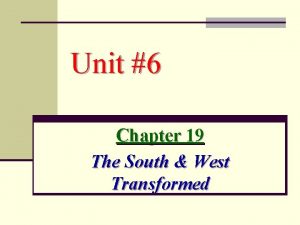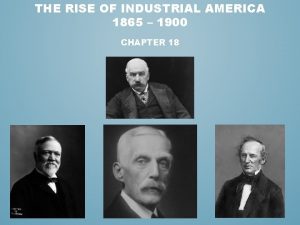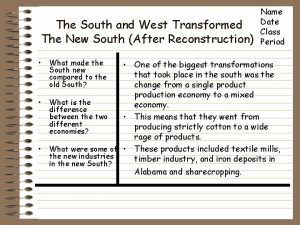The Last West and the New South 1865














- Slides: 14

The Last West and the New South 1865 -1900

Essential Questions To what extent did the natural environment shape the development of the West beyond the Mississippi and the lives of those who lived and settled there? How important were other factors? Analyze the ways in which technology, government policy, and economic conditions changed the American frontier in the period 1865 - 1900.

Post War Expansion Regions of settlement: Great Plains Rocky Mountains Western Plateau “Great American Desert” Less than 15 inches of rainfall annually Impact on American Indians Loss of land Changes to way of life The buffalo

The Mining Frontier Pike’s Peak, CO (1859) – gold – 100, 000 Comstock Lode (1859) Homestead Mine $340 million in gold and silver Black Hills, Dakotas Billion Dollar Mine Boom Towns Homestead, SD Virginia City, NV – Mark Twain by the early 1860’s all easily extractable gold and silver gone (placer mining) San Francisco, Sacramento, Denver remain as urban centers Big business takes over Ghost Towns dynamite introduced in 1870’s Impact: Social: Nativism Political: Chinese Exclusion Act Economic: Gold vs. Silver, Inflation Populist Movement

Texas as the Model Mexican tools and clothing Longhorn Cattle thrived on dry, grassy plains Rise of Beef Trusts disappearance of buffalo, soaring population increase, invention of refrigerated car huge rise in demand Chicago & St. Louis as centers antebellum: $3 -5 for cattle postbellum: $30 -50 for cattle Abilene, KS – cattle drives Chisholm and Goodnight-Loving Trails The “Long Drive” The Open Range 2/5 of Texas used for cattle grazing The Cattle Frontier branding Decline Invention of Barbed Wire Winter of ‘ 85 -’ 86 (85% losses) Drought of ‘ 86 & Winter of ‘ 87

The Farming Frontier Homestead Act (1862) 160 free acres to families Req’s: Must be actively farmed for 5 years, and must have residency established for at least 6 months Over 500, 000 families settled on homesteads Problems and Solutions Severe weather, lack of water, cold weather, high rate of pestilence and disease Inventions/innovations Barbed wire Windmills Dry-farming techniques – used the moisture that was available Dams and irrigation Falling crop prices and rising costs led to many failures

The Closing of the Frontier Opening of the Oklahoma Territory (1889) The Land Rush “boomers” and “sooners” rush to settle End of the “frontier” Turner’s Frontier Thesis (1893) Views – settling on the frontier was a social leveler, breaking down class distinctions, fostered social and political democracy Reaction – would the United States be condemned to follow the patterns of class division and social conflict like Europe? Effects/Lasting Impact – large movement to cities and industrialized areas. Era of the western frontier was coming to a close, but the dominance of rural America was also on a decline.

American Indians in the West Roughly 2/3 of the remaining western tribes lived in the Great Plains Reservation Policy Indian Wars Impact of horse Reliance on buffalo Sand Creek Fetterman Massacre Little Big Horn Meeker Massacre Wounded Knee – marked the end of Indian Wars Assimilationists A Century of Dishonor (Helen Hunt Jackson, 1881) – advocate formal education, job training, and conversion to Christianity Dawes Severalty Act (1887) – designed to break up tribal organizations; 160 acres per family – US citizenship granted to those who stayed on the land for 25 years and adopted the habits of civilized life. 47 million acres

The Conservation Movement Growth of State Parks and Creation of National Parks Yellowstone (1872), Yosemite (1890) Creation of Forest Reserves and the Federal Forest Service (Schurz – Sec. State) 33 million acres protected under Harrison & Cleveland Forest Reserve Act 1891 John Muir and the Sierra Club (1892) – preserve national areas from human interference

The New South Economic Progress Continued Poverty Steel (AL), Lumber (TN), Tobacco (VA), Textiles (GA, NC, SC) Expansion of Rails Most growth due to northern financing Lack of education, limited skills Weak political leadership Agriculture Limited Diversification New Crop Rotation – Peanuts, Sweet Potatoes, Soybeans (G. W. Carver) Plight of poor farmers Rise of Southern Farmers’ Alliances (segregated)

Segregation & The Rise of Jim Crow Effects of Redeemer Governments Civil Rights Cases (1883) Congress couldn’t regulate intrastate and private commerce including issues with discrimination Plessy v. Ferguson (1896) “Separate but equal” Led to rise of “Jim Crow” laws Loss of Civil Rights Democrats who came to power in the South after Reconstruction – redeemers – supported by businesses and white supremacists Discrimination and the Supreme Court Demise of black voter registration Literacy tests, poll taxes, and grandfather clauses Vigilante “justice” Lynching Response to Segregation International Migration Society – help with emigration from Africa Pap Singleton’s “Exodusters” – when African Americans moved to Kansas and Oklahoma Ida B. Wells Booker T. Washington Tuskegee, Negro Business League Up From Slavery W. E. B. Du. Bois NAACP “Talented Tenth” Souls of Black Folk

Farm Problems: North, South, and West Changes in Agriculture Falling Prices Industrialization enters into the fields Competition from abroad Impact on loans & mortgages Rising Costs associated w/selling, buying equipment, and taxes

Fighting Back National Grange Movement Interstate Commerce Act (1886) Patrons of Husbandry (Oliver Kelley, 1868) Formation of farmer’s cooperatives Push for “Granger Laws” Target railroads Effect of Wabash case Overturned Munn v. Illinois (1877) -States can’t regulate railroads (interstate) Creation of the ICC Growth of Farmers’ Alliances Over 1 million members in regional alliances by 1890 Ocala Platform (1890) Tenets: Direct election of Senators, lower tariff rates, graduated income tax, federal banking system Would later become part of the Omaha Platform & the Populist movement

Short Answer Review The farmers of the United States are up in arms. They are the bone and sinew of the nation; they produce the largest share of its wealth; but they are getting, they say, the smallest share for themselves. The American farmer is steadily losing ground. His burdens are heavier every year and his gains are more meager; he is beginning to fear that he may be sinking into a servile condition. He has waited long for the redress of his grievances; he purposes to wait no longer” - Washington Gladden, minister, Forum, November, 1890 a) Briefly explain an event from the Gilded Age that supports that the farmers were “up in arms. ” b) Briefly explain what evidence would support the statement about farmers in this era that “His burdens are heavier every year and his gains are more meager. ” c) Explain what the writer most likely had in mind when he states, “he is beginning to fear that he may be sinking into a servile condition. ”
 The last west and the new south
The last west and the new south Soddie
Soddie Old west vs new west
Old west vs new west Rewla khanpur red light area
Rewla khanpur red light area Old south vs new south streetcar named desire
Old south vs new south streetcar named desire Lines that run east and west but measure north and south
Lines that run east and west but measure north and south East is east and west is west
East is east and west is west Swana region
Swana region South west london health and care partnership
South west london health and care partnership The south and west transformed
The south and west transformed South west and wales doctoral training partnership
South west and wales doctoral training partnership Urban america 1865 to 1896
Urban america 1865 to 1896 St helen’s smelting co v tipping (1865)
St helen’s smelting co v tipping (1865) The rise of industrial america 1865-1900
The rise of industrial america 1865-1900 Four features of industrial manufacturing (1865-1900)
Four features of industrial manufacturing (1865-1900)

